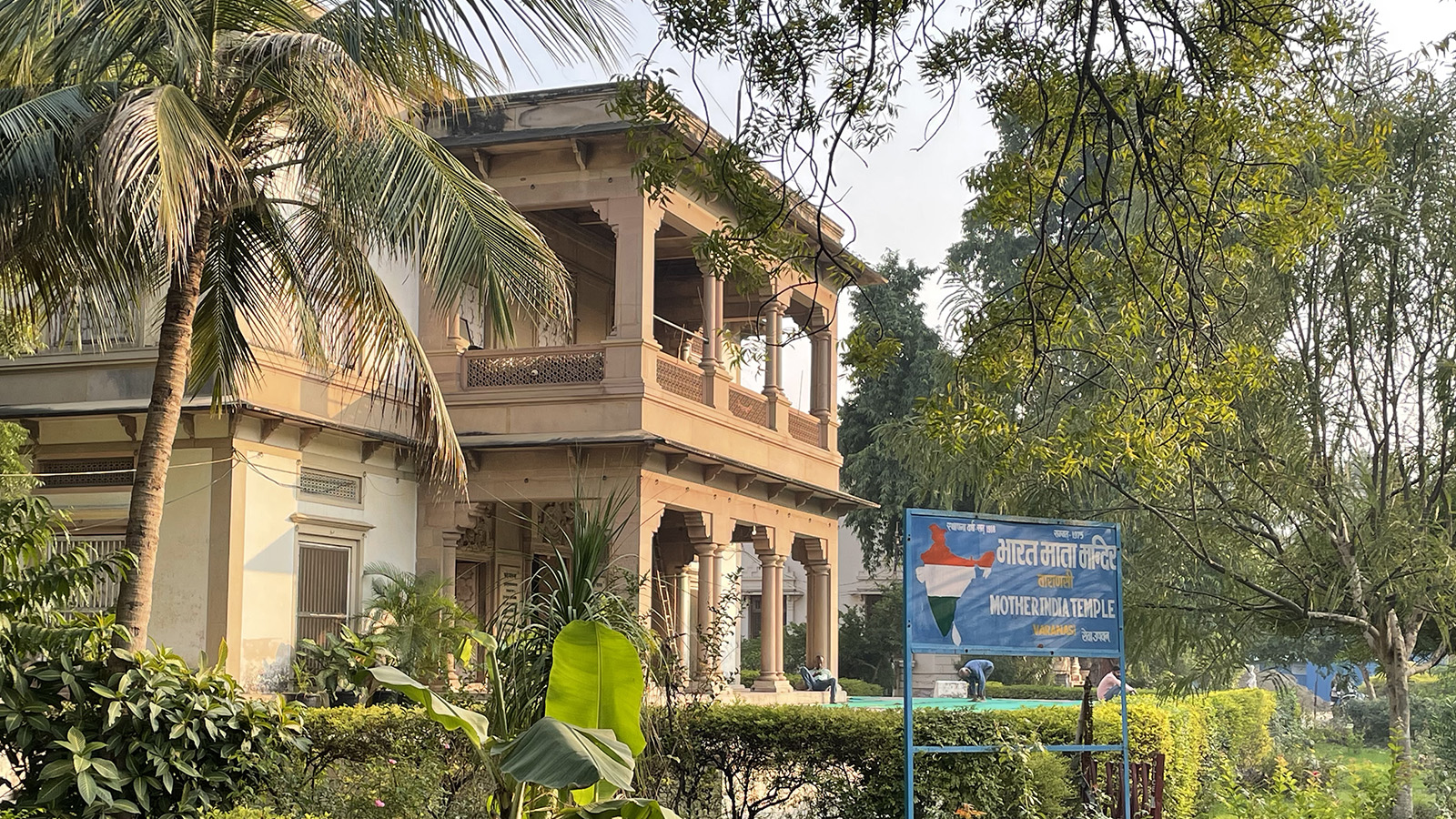
The exterior of Bharat Mata Mandir, or Mother India Temple, in Varanasi, India, Dec. 11, 2023. (RNS photo/Richa Karmarkar)
VARANASI, India (RNS) — The holy city of Varanasi is a place of deep devotion, where pilgrims of the ancient Hindu tradition from around the world travel to worship at the temples that fill every block of the city once dubbed Banaras by India’s British rulers.
But tucked away on the historic streets is a 100-year-old temple where there are no idols, rituals or scriptures. This temple is dedicated to the goddess of the nation: Mother India.
Conceived by anti-British freedom fighter Shiv Prasad Gupta in 1918 and built in secret, the temple was inaugurated in 1936 by Mahatma Gandhi, who bore a vision of India as a country for all faiths and races.
“I hope that this temple will take the form of a worldwide platform for all religions, along with Harijans, and of all castes and beliefs, and it would contribute to feelings of religious unity, peace and love in this country,” Gandhi said at the time.
But the Bharat Mata Mandir, whose main attraction is a scaled topographic map of pre-partition India, is a uniquely Indian showing of religious patriotism. And its roots in India’s struggle for independence have made it a particularly apt spot for a visit from Prime Minister Narendra Modi, who toured the town on Sunday (Dec. 17) as part of his 43nd visit to Varanasi since taking office.
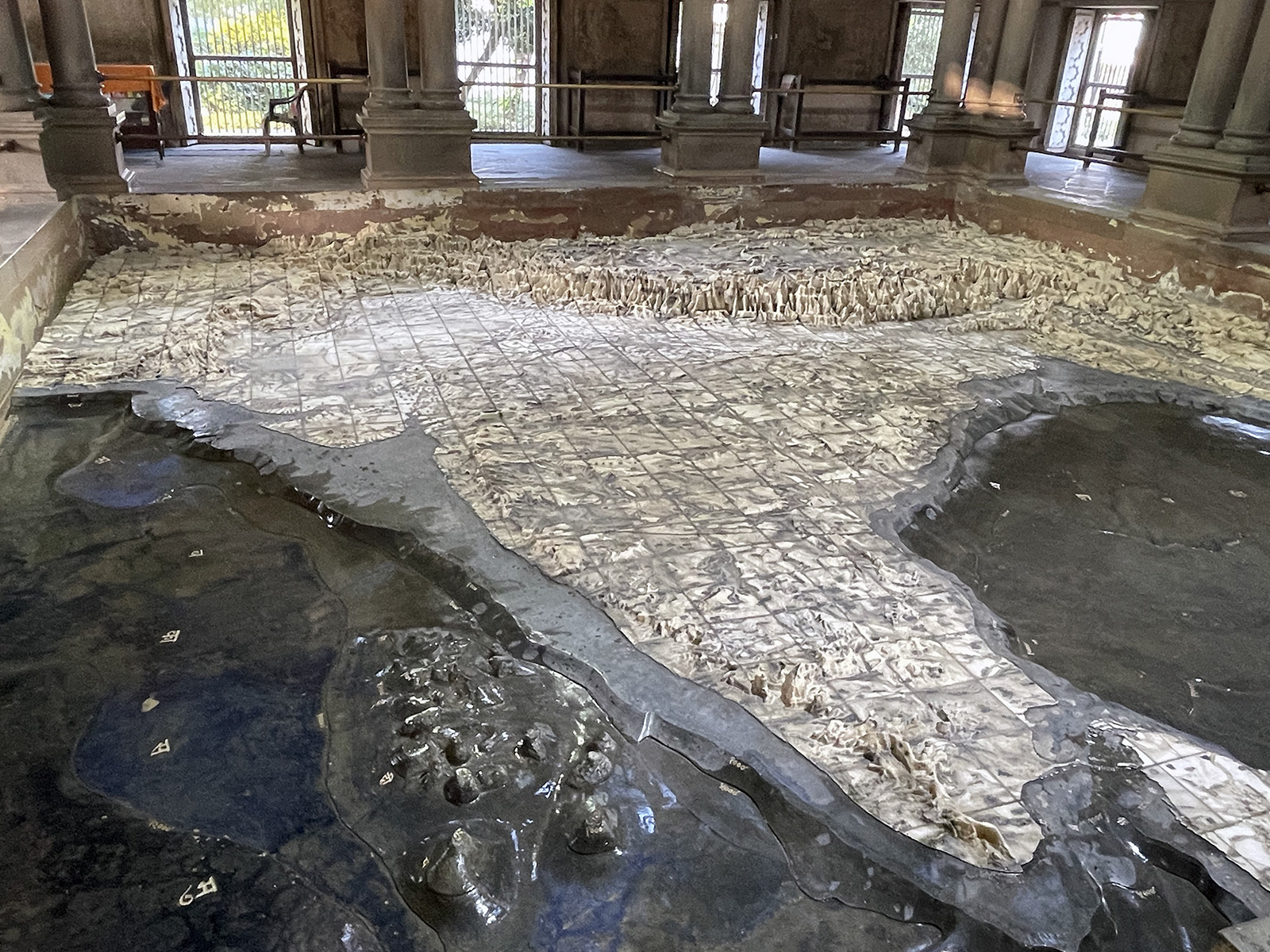
The scaled topographic map of pre-partition India at Bharat Mata Mandir, or Mother India Temple, in Varanasi, India, Dec. 11, 2023. (RNS photo/Richa Karmarkar)
“Since Modi has come into power, the feeling that the song ‘Saare Jahan Se Accha, Hindustan Humara’ invoked has become stronger,” said the temple’s caretaker, Balram Singh, referring to the resistance anthem written in Urdu by the Muslim poet Mohammed Iqbal that translates to “out of every land, our Hindustan is the best.”
Singh, whose family members have been caretakers at the mandir for four generations, said of Modi, “He motivated us to be proud to be Indian.”
Since Modi’s 2014 election, his government has bolstered religious pride for its Hindu citizens, some of whom are in favor of a Hindu rashtra, or nation. Slogans from the days of British rule such as “Bharat Mata Ki Jai” (Hail Mother India) or “Vande Mataram” (Praise the Motherland) have now come to represent an ideology that many in his constituency hold — a distinctly religious allegiance to the mother goddess of India, or Bharat.
While many critics decry Modi’s leadership for what they say is deliberate exclusion of the country’s non-Hindu minorities, many residents of the holy city disagree.
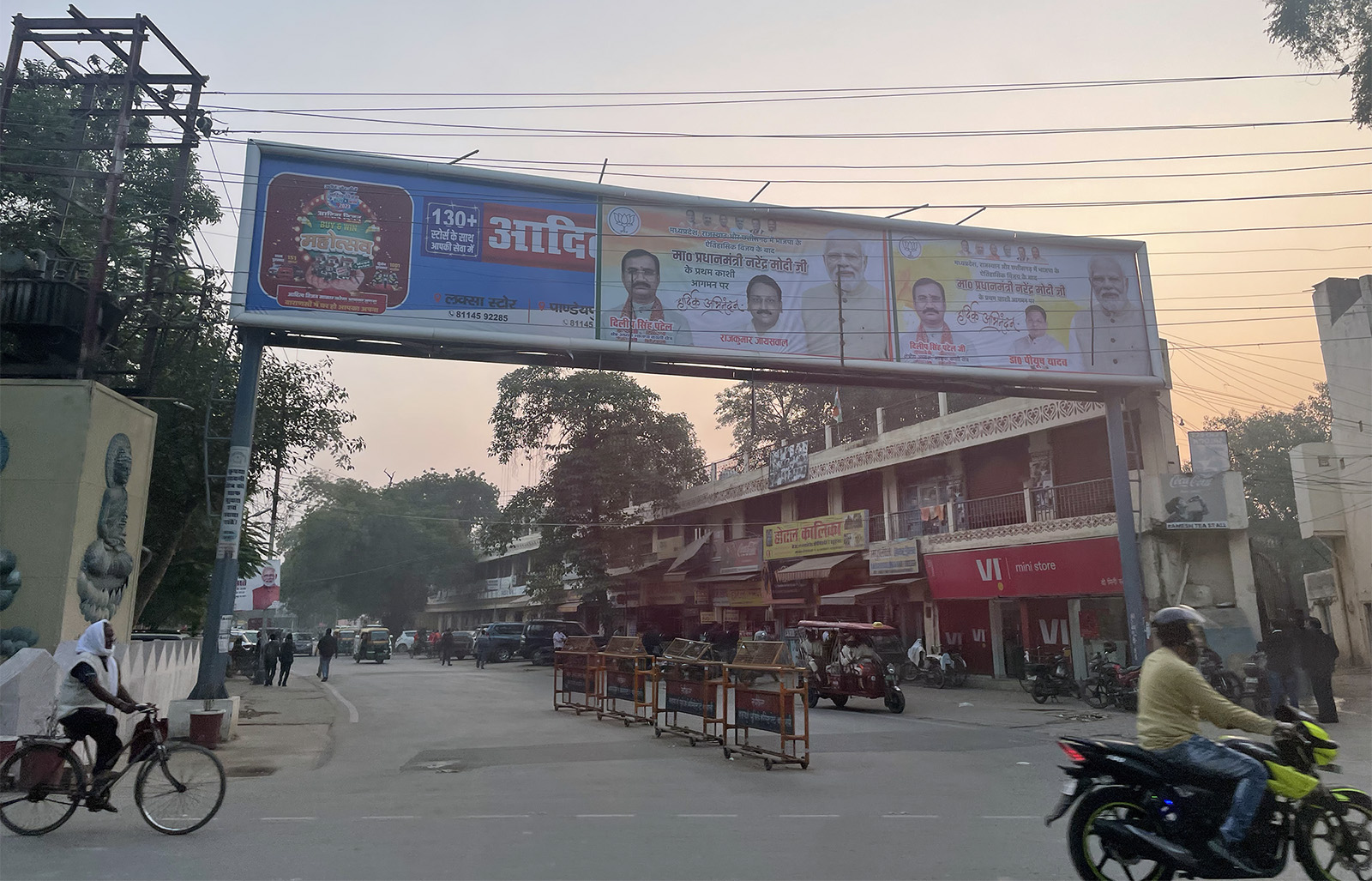
Billboards welcome Prime Minister Narendra Modi ahead of his Dec. 17, 2023, visit to Varanasi, India. (RNS photo/Richa Karmarkar)
Raju Singh, Balram Singh’s grandson, said Modi restored an idea of India to what it was like before it was divided into India and Pakistan. Separation between religious communities, he said, was not a part of Akhand Bharat, or unified India.
“India is the only country where people of all religions and races live together in harmony,” said the younger Singh. “Despite anyone’s religion or caste, Shiv Prasad Gupta made this temple to be open to all, without any religious restrictions or discrimination. All people who are Indian can come and worship Bharat Mata.”
Singh points out the sun and moon at the entrance of the temple, symbols associated with the sun god Surya of Hinduism and Islam, respectively. He also stood proudly in front of a map of Akhand Bharat, which includes present-day Afghanistan, Bangladesh, Bhutan, India, Maldives, Myanmar, Nepal, Pakistan, Sri Lanka and Tibet. The map was hand carved from more than 760 slabs of makrana marble, a white stone also used in the construction of the Taj Mahal.
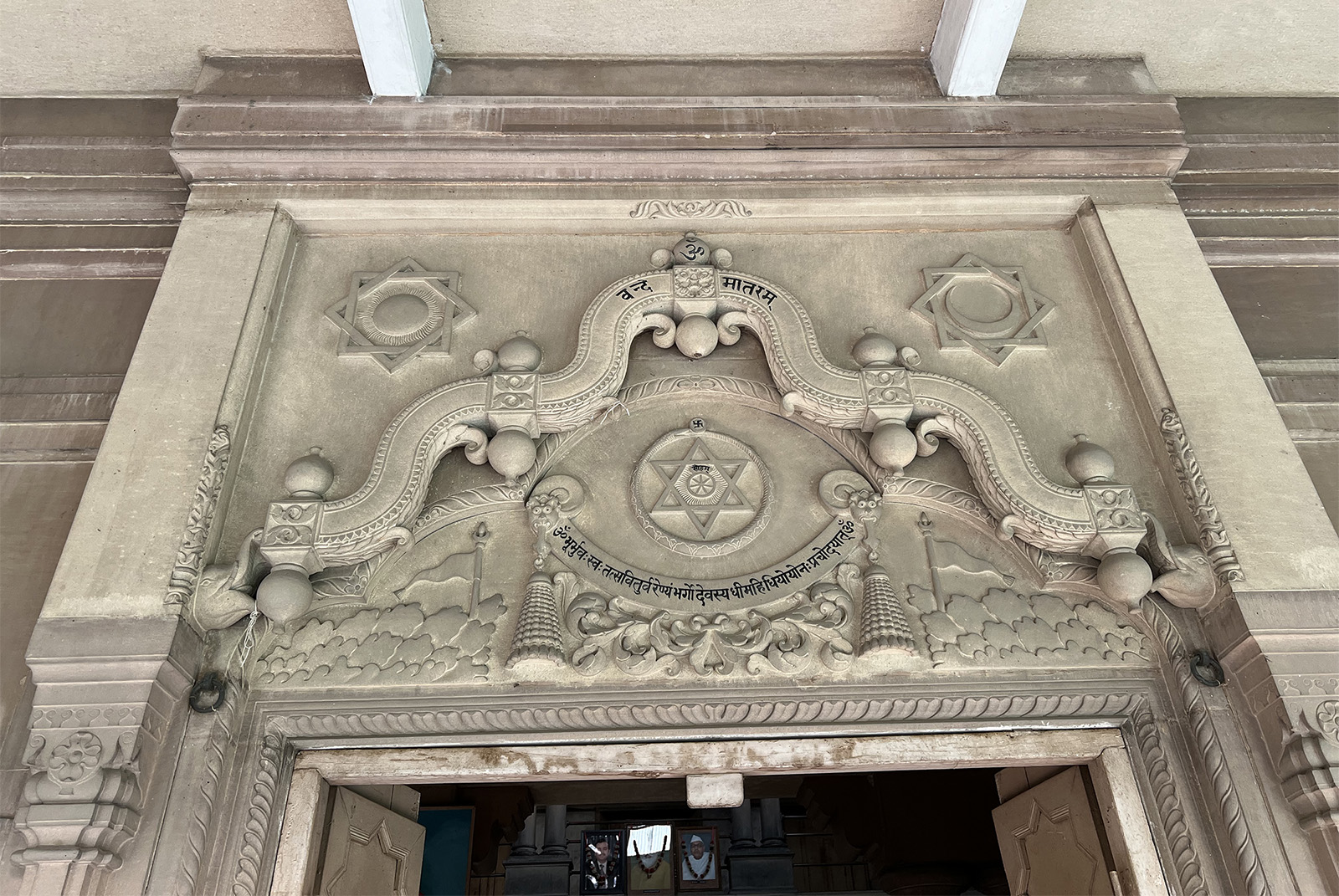
The sun, left, and moon above an entrance to the Bharat Mata Mandir, or Mother India Temple, in Varanasi, India, Dec. 11, 2023. (RNS photo/Richa Karmarkar)
“This is our privilege that on this map, we can see how 100 years ago the united country looked,” said Singh. “We should remember how that was.”
Watching over the map from above is a poster depicting Bharat Mata — a personification of the goddess Durga popularized during the fight for independence, in which she wears a saffron-colored sari and stands next to a lion, the animal symbol of India.
Indian leaders of the likes of Rajendra Prasad, Indira Gandhi and Jawaharlal Nehru have all paid their respects at the Bharat Mata Mandir through the years, offering her the traditional Hindu garland of flowers. Tourists to Varanasi come to revere the goddess especially on India’s Independence Day and Republic Day.
But for many pilgrims who come across the mandir, says Balram Singh, there is confusion about its status as a temple among the other holy sites of Varanasi, all of which contain at least one murti, or idol. To them, Singh tells a personal story of growing up without a mother. The mother he is most loyal to, he says, is the woman who has nourished him the most.
“For me, she is my Bharat Mata,” he said. “She provides us with food and water. She is everything to us.”
In the Hindu faith, according to Raju Singh, four holy mothers are worshipped — one’s birth mother; Gau Mata, or mother cow; Bharat Mata, Mother India; and Ma Ganga, the sacred Ganges River that flows through Varanasi.
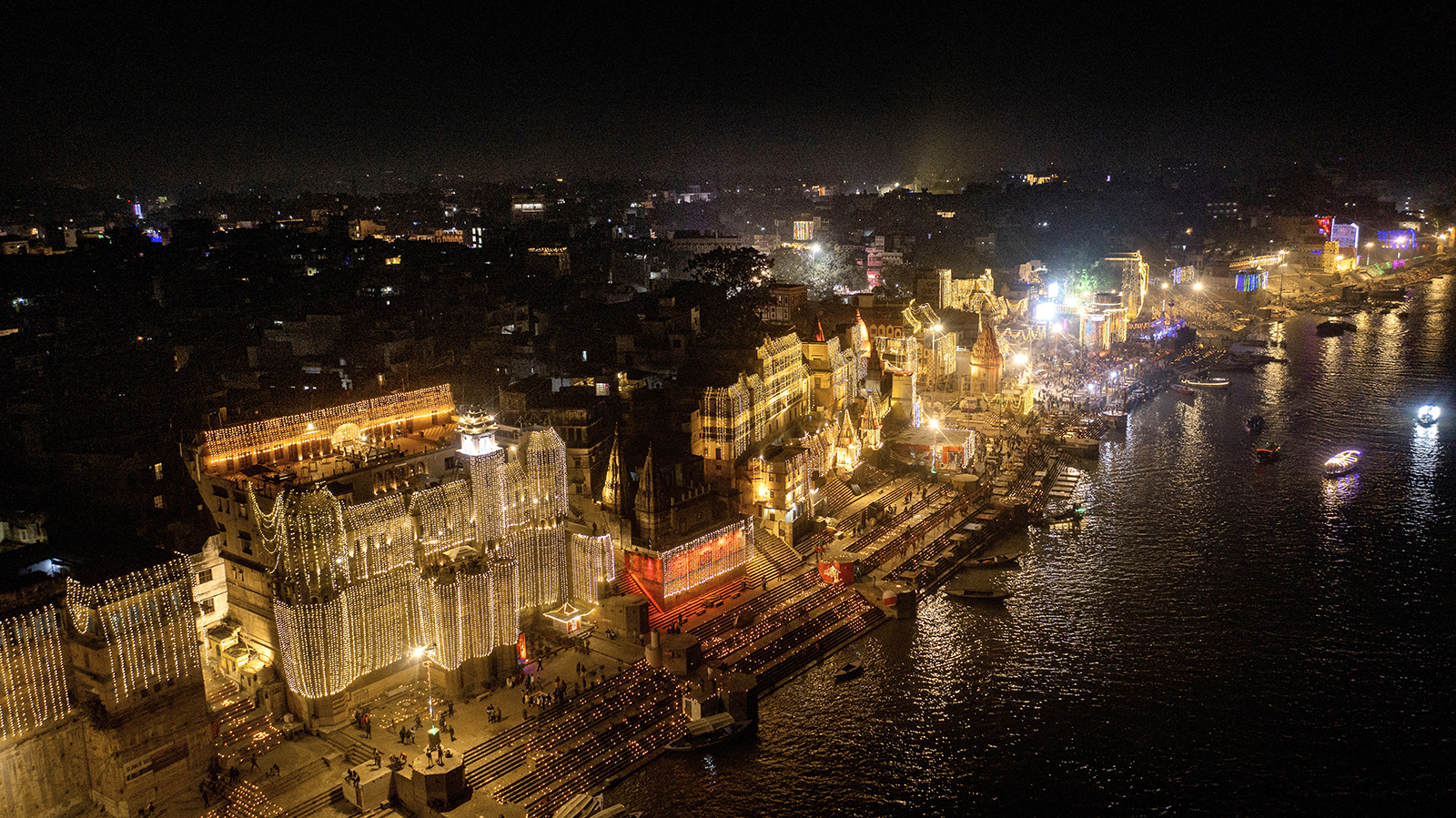
Illuminated ghats on the bank of the Ganges River are seen in the evening after the inauguration of Kashi Vishwanath Dham Corridor, a promenade that connects the sacred river with the centuries-old temple dedicated to Lord Shiva in Varanasi, India, Dec. 13, 2021. (AP Photo/Rajesh Kumar Singh)
As part of a massive refurbishment of Varanasi, Modi has worked to ensure that the river, once one of the most contaminated waterways, is clean, starting with his strict punishable ban of littering. Modi’s 2014 initiative, Swachh Bharat Abhiyan, or Clean India Mission, has created a litany of new followers in the city of Varanasi, according to lifelong resident Manoj Kumar.
“He picked up the first plow himself and dug the mud out of the river,” said Kumar. “We’ve never had a leader like him.”
In 2021, Modi revitalized one of the most sacred shrines of Shiva, adding a tourism-boosting 50-acre corridor leading to the ancient Kashi Vishwanath Temple. On his most recent visit, Modi announced plans for 17 more building projects in Varanasi, worth more than 12,000 crore rupees, or more than $1 billion.

Indian Prime Minister Narendra Modi speaks during the inauguration of Kashi Vishwanath Dham Corridor, a promenade that connects the sacred Ganges River with the centuries-old temple dedicated to Lord Shiva in Varanasi, India, Dec. 13, 2021. (AP Photo/Rajesh Kumar Singh)
“Everything he has done has been for the country, not for himself,” said Kumar, who like many in Varanasi is a devotee of Lord Shiva. “He may have come late, but he has done so much for us.”
Yet despite Modi’s approval among many Hindu Indians, his critics remain wary of the pro-Hindu rhetoric his followers espouse. A debate roars on in Indian circles surrounding one of his most popular slogans: “Bharat Mata Ki Jai.”
Indian Muslim journalist Arfa Khanum Sherwani has said that the words force a communal and religious aspect of nationalism, one that reveres a mythological deity found only in Hinduism. Others, such as prominent historian of women Tanika Sarkar, has suggested that those who hail India as a maternal figure might be more likely to act militantly on her behalf.
“If you live here, and you do not say Bharat Mata Ki Jai and Vande Mataram, you are a traitor of this country,” said T. Raja Singh of the BJP at a speech in Hyderabad, India, in November.
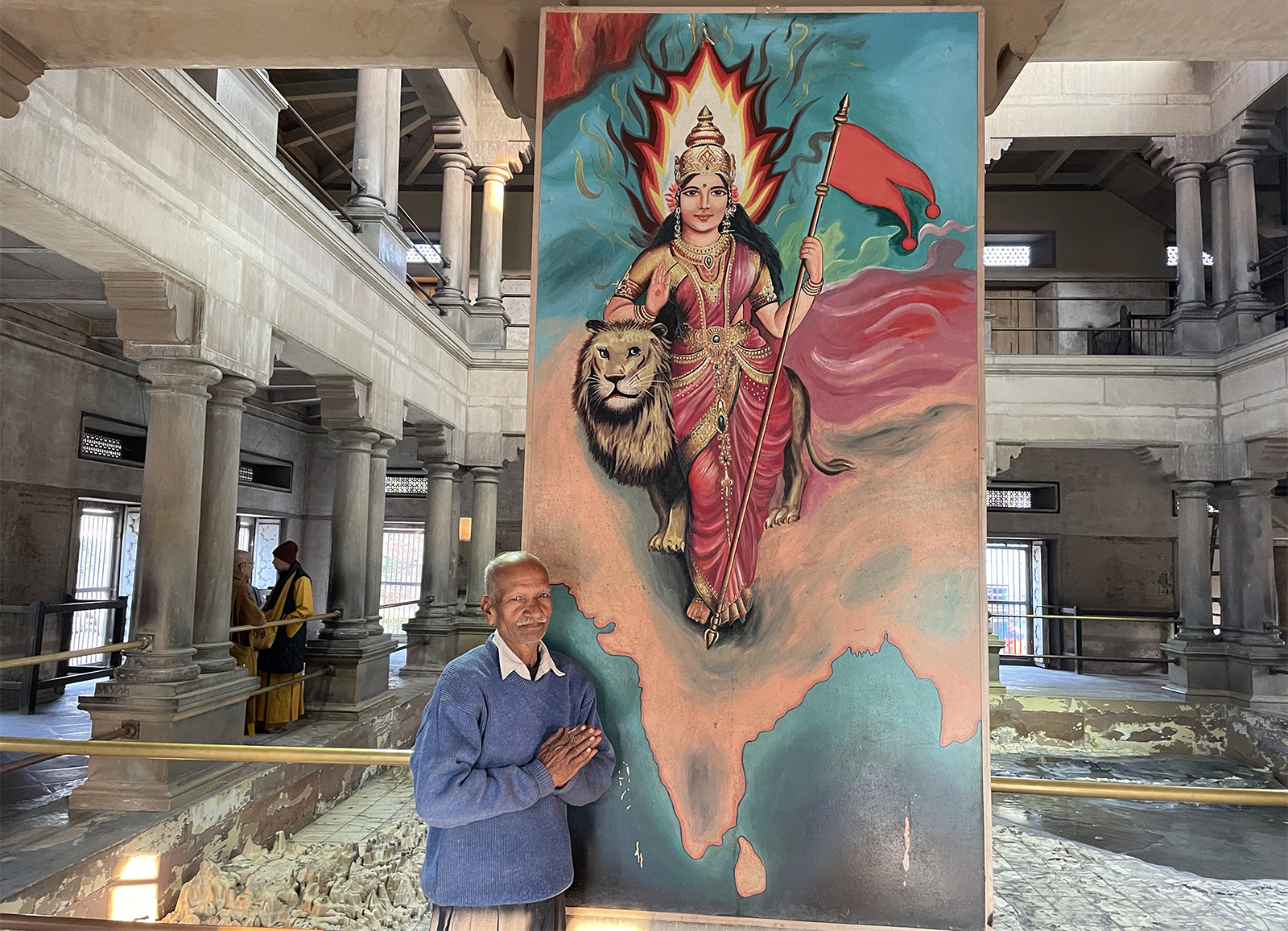
Balram Singh, caretaker of the Bharat Mata Mandir in Varanasi, India, poses with the main Bharat Mata painting at the temple, Dec. 11, 2023. (RNS photo/Richa Karmarkar)
Balram Singh, who has been protecting his Bharat Mata for 35 years, said Modi’s government emboldens him to share his undying loyalty to the nation.
“As long as I live, I will keep serving Bharat Mata,” he said. “May Hindustan remain free, and Pakistan be destroyed.”




